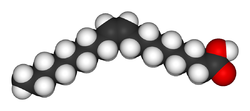- Monounsaturated fat
-
Types of fats in food - Unsaturated fat
- Monounsaturated fat
- Polyunsaturated fat
- Trans fat
- Cis fat
- Omega fatty acids:
- Saturated fat
See also - For discussion how dietary fats affect cardiovascular health, see Diet and heart disease.
In biochemistry and nutrition, monounsaturated fats or MUFA (MonoUnsaturated Fatty Acid) are fatty acids that have one double bond in the fatty acid chain and all of the remainder of the carbon atoms in the chain are single-bonded. By contrast, polyunsaturated fatty acids have more than one double bond.
Fatty acids are long-chained molecules having a methyl group at one end and a carboxylic acid group at the other end. Fatty acid viscosity (thickness) and melting temperature increases with decreasing number of double bonds. Therefore, monounsaturated fatty acids have a higher melting point than polyunsaturated fatty acids (more double bonds) and a lower melting point than saturated fatty acids (no double bonds). Monounsaturated fatty acids are liquids at room temperature and semisolid or solid when refrigerated.
Contents
Molecular description: oleic acid
Common monounsaturated fatty acids are palmitoleic acid (16:1 n−7), cis-vaccenic acid (18:1 n−7) and oleic acid (18:1 n−9). Palmitoleic acid has 16 carbon atoms with the first double bond occurring 7 carbon atoms away from the methyl group (and 9 carbons from the carboxyl end). It can be lengthened to the 18-carbon cis-vaccenic acid. Oleic acid has 18 carbon atoms with the first double bond occurring 9 carbon atoms away from the carboxylic acid group. The illustrations below show a molecule of oleic acid in Lewis formula and as a space-filling model.


Relation to health
Although polyunsaturated fats protect against cardiovascular disease by providing more membrane fluidity than monounsaturated fats, they are more vulnerable to lipid peroxidation (rancidity). On the other hand, some monounsaturated fatty acids (in the same way as saturated fats) may promote insulin resistance, whereas polyunsaturated fatty acids may be protective against insulin resistance.[1][2] In contrast to this, the large scale KANWU study found that neither dietary monounsaturated or supplemented polyunsaturated fats (in the form of fish oil) affected insulin sensitivity while increased consumption of saturated fat significantly decreased insulin sensitivity.[3]
Foods containing monounsaturated fats reduce low-density lipoprotein (LDL) cholesterol, while possibly increasing high-density lipoprotein (HDL) cholesterol.[4] However, their true ability to raise HDL is still in debate.
Levels of oleic and monounsaturated fatty acids in red blood cell membranes were positively associated with breast cancer risk. The saturation index (SI) of the same membranes was inversely associated with breast cancer risk. Monounsaturated fats and low SI in erythrocyte membranes are predictors of postmenopausal breast cancer. Both of these variables depend on the activity of the enzyme 9-d delta 9 desaturase.[5]
In children, consumption of monounsaturated oils is associated with healthier serum lipid profiles.[6]
Natural sources
Monounsaturated fats are found in natural foods such as red meat, whole milk products, nuts and high fat fruits such as olives and avocados. Olive oil is about 75% monounsaturated fat. Canola oil and Cashews are both about 58% monounsaturated fat. Tallow (beef fat) is about 50% monounsaturated fat and lard is about 40% monounsaturated fat. Other sources include macadamia nut oil, grapeseed oil, groundnut oil (peanut oil), sesame oil, corn oil, popcorn, whole grain wheat, cereal, oatmeal, safflower oil, sunflower oil, tea-oil Camellia, and avocado oil.
See also
- High density lipoprotein
- Saturated fat
- Unsaturated fat
- Polyunsaturated fat
References
- ^ Lovejoy, JC (2002). "The influence of dietary fat on insulin resistance". Current Diabetes Reports 2 (5): 435–40. doi:10.1007/s11892-002-0098-y. PMID 12643169.
- ^ Satoshi Fukuchi; Hamaguchi, K; Seike, M; Himeno, K; Sakata, T; Yoshimatsu, H (June 1, 2004). "Role of Fatty Acid Composition in the Development of Metabolic Disorders in Sucrose-Induced Obese Rats". Experimental Biology and Medicine 229 (6): 486–93. PMID 15169967. http://www.ebmonline.org/cgi/content/full/229/6/486.
- ^ Vessby B, Unsitupa M, Hermansen K, Riccardi G, Rivellese AA, Tapsell LC, Nälsén C, Berglund L, Louheranta A, Rasmussen BM, Calvert GD, Maffetone A, Pedersen E, Gustafsson IB, Storlien LH (2001). "Substituting dietary saturated for monounsaturated fat impairs insulin sensitivity in healthy men and women: The KANWU Study". Diabetologia 44 (3): 312–9. doi:10.1007/s001250051620. PMID 11317662. http://link.springer-ny.com/link/service/journals/00125/bibs/1044003/10440312.htm.
- ^ "You Can Control Your Cholesterol: A Guide to Low-Cholesterol Living". Merck & Co. Inc.. http://www.mercksource.com/pp/us/cns/cns_krames_template.jspzQzpgzEzzSzppdocszSzuszSzcnszSzcontentzSzkrameszSz1292_01zPzhtm. Retrieved 2009-03-14.
- ^ Valeria Pala, Vittorio Krogh, Paola Muti, Véronique Chajès, Elio Riboli, Andrea Micheli, Mitra Saadatian, Sabina Sieri, Franco Berrino (July 18, 2001). "Erythrocyte Membrane Fatty Acids and Subsequent Breast Cancer: a Prospective Italian Study". JNCL 93 (14): 1088–95. doi:10.1093/jnci/93.14.1088. PMID 11459870. http://jnci.oxfordjournals.org/cgi/content/full/93/14/1088. Retrieved 2008-11-30.
- ^ Sanchez-Bayle M, Gonzalez-Requejo A, Pelaez MJ, Morales MT, Asensio-Anton J, Anton-Pacheco E (2008). "A cross-sectional study of dietary habits and lipid profiles. The Rivas-Vaciamadrid study". Eur. J. Pediatr. 167 (2): 149–54. doi:10.1007/s00431-007-0439-6. PMID 17333272.
- ^ a b c .nutritiondata.com --> Oil, vegetable, sunflower Retrieved on September 27, 2010
- ^ a b c .nutritiondata.com --> Egg, yolk, raw, fresh Retrieved on August 24, 2009
- ^ Feinberg School > Nutrition > Nutrition Fact Sheet: Lipids Northwestern University. Retrieved on August 24, 2009
External links
- Unsaturated fat
- Food science
- Fatty acids
- Lipids
- Nutrition
Wikimedia Foundation. 2010.
